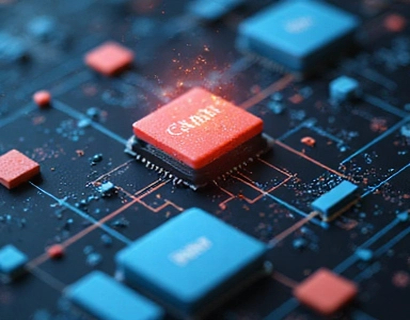Revolutionizing User Experiences: The Synergy of Crypto and AI in Next-Gen Digital Transformation
The intersection of cryptocurrency and artificial intelligence (AI) is paving the way for a new era of digital transformation. This convergence is not just about combining two advanced technologies but about creating a synergy that enhances user experiences, secures transactions, and opens up unprecedented opportunities for innovation. As we delve into this topic, it's essential to understand how these technologies are individually impacting the digital landscape and how their integration is redefining user interactions.
The Evolution of Cryptocurrency
Cryptocurrency, since its inception with Bitcoin in 2009, has evolved from a niche digital currency to a transformative force in the financial and technological sectors. Initially met with skepticism, cryptocurrencies have gained widespread acceptance, driven by their decentralized nature, security, and potential for financial inclusivity. The underlying blockchain technology, a distributed ledger that ensures transparency and immutability, has become a cornerstone for various applications beyond finance.
Beyond digital currencies, blockchain's capabilities have been harnessed in areas such as supply chain management, healthcare, and voting systems. However, the true potential of blockchain is being unlocked through its integration with AI, creating a powerful toolset for developers and businesses alike.
AI: The Intelligence Behind the Curve
Artificial intelligence, with its ability to learn, reason, and act, has been revolutionizing industries by automating processes, providing insights, and enhancing decision-making. From virtual assistants to predictive analytics, AI is becoming an indispensable part of our daily lives. The integration of AI with blockchain technology is particularly promising, as it combines the security and transparency of blockchain with the intelligence and efficiency of AI.
This synergy is leading to the development of smart contracts that can execute complex tasks based on predefined conditions, self-sovereign identity solutions that give users control over their personal data, and decentralized finance (DeFi) platforms that offer financial services without traditional intermediaries.
Enhancing User Experiences through Blockchain and AI
The combination of blockchain and AI is not only transforming backend processes but also significantly enhancing user experiences. One of the key areas where this is evident is in personalized recommendations. By leveraging AI algorithms to analyze user behavior and preferences, combined with the secure and transparent data storage provided by blockchain, platforms can offer highly personalized and trustworthy recommendations.
For instance, in content streaming services, AI can curate a tailored playlist based on a user's viewing history, while blockchain ensures that the data used for personalization is secure and the user's preferences are verifiably theirs, reducing the risk of data breaches and unauthorized access.
Secure and Transparent Transactions
Another critical aspect is the security and transparency of transactions. AI can detect and prevent fraudulent activities by analyzing patterns and anomalies in real-time. When integrated with blockchain, this capability is amplified, as every transaction is recorded on an immutable ledger. This dual approach ensures that users can transact with confidence, knowing that their transactions are secure and verifiable.
In the realm of digital identities, blockchain and AI are creating self-sovereign identity solutions. These solutions allow users to control their personal data and authenticate themselves without relying on centralized authorities. AI can enhance this process by verifying identities through biometric data and behavioral patterns, ensuring a high level of security and convenience.
Decentralized Applications and AI Integration
Decentralized applications (dApps) are at the forefront of the blockchain-AI convergence. These applications run on blockchain networks and leverage AI to provide advanced functionalities. For example, in the gaming industry, dApps can use AI to create dynamic and adaptive game environments, ensuring a unique experience for each player while maintaining the integrity of the game through blockchain's transparency and security.
In the healthcare sector, dApps can utilize AI for diagnostic purposes, analyzing medical data to provide accurate and timely insights. Blockchain ensures that patient data is securely stored and shared only with authorized parties, maintaining patient privacy and data integrity.
Challenges and Considerations
While the potential of blockchain and AI is vast, there are challenges that need to be addressed. Scalability remains a significant issue for blockchain technology, as many networks struggle to handle high transaction volumes. AI models, particularly those requiring extensive training, demand substantial computational resources, which can be costly and energy-intensive.
Moreover, the regulatory landscape for both blockchain and AI is still evolving. Ensuring compliance with varying regulations across different jurisdictions is crucial for the widespread adoption of these technologies. Privacy concerns also need to be carefully managed, as the integration of AI and blockchain involves handling sensitive data.
Innovative Solutions and Future Directions
To overcome these challenges, ongoing research and development are essential. Layer 2 solutions and cross-chain interoperability are being explored to enhance blockchain scalability. In the AI domain, advancements in federated learning and edge computing are making AI models more efficient and less resource-intensive.
Looking ahead, the integration of blockchain and AI is poised to drive further innovation. The development of AI-powered blockchain governance models can enhance decentralized decision-making processes, while AI-driven security solutions can protect blockchain networks from emerging threats.
Conclusion
The convergence of cryptocurrency and AI is not just a technological trend but a fundamental shift in how we interact with digital systems. By combining the security, transparency, and decentralization of blockchain with the intelligence and efficiency of AI, we are witnessing the birth of a new digital paradigm. This synergy is set to revolutionize user experiences, drive innovation, and open up new possibilities for businesses and individuals alike. As we continue to explore and harness this powerful combination, the future of digital transformation looks brighter and more promising than ever.











































